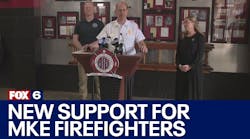BALTIMORE, MD – One size doesn’t fit all.
That theme surfaced repeatedly this past weekend as fire officials discussed how to assist their personnel with the mental stresses of their jobs.
Consultants with the National Fallen Firefighters Foundation explained not only their research findings, but presented a host of ideas to keep responders mentally fit.
A conference to roll out programs for Initiative 13 was funded in part by the Centers for Disease Control and Prevention and an AFG grant.
Psychological support needs to be part of the daily regime just as time at the gym, said Dr. Richard Gist, principal assistant to the Kansas City Fire Chief.
Gist, a NFFF consultant, said Initiative 13 goes way beyond just making sure firefighters and their families have access to psychological support.
Over the past five years, Gist and Vickie Taylor, a behavioral health consultant with the NFFF, have been working to establish the proper tools so every person on the crew can help take care of themselves and their comrades.
Taylor said leading experts in all facets of psychological health as well as fire and EMS officials were involved to help them develop “a whole set of products” that responders can use to keep people mentally fit to do their jobs.
Conducting an After Action Review (AAR) should become as routine as restocking or cleaning the equipment used. Every time the wheels roll, Gist and Taylor say crews should consider five things -- What was our mission? What went well? What could have gone better? What might we have done differently? Who needs to know?
Throughout the weekend session, it was stressed that the AAR conducted by every team, every time insures that Everyone Goes Home.
Taylor explained that Stress First Aid techniques are built on the same principals that responders use daily to assist citizens. The key is learning to pay attention every day to the behavior of colleagues or people who work for you.
She added that this is “not a program rolled out after an incident,” this is something that should become second nature.
Gist added: “Nobody knows you better than your best friend…”
He said other firefighters and related organizations need to work together to keep each other safe.
They say the backbone or success of peer support programs in all departments is confidentiality which also must continue throughout the mental health care process.
And, Taylor says it’s also imperative that clinicians are knowledgeable about the fire and rescue service.
Gist added that it’s their hope that AAR and stress first aid become part of every firefighters’ repertoire.
Yet, he added that the programs will be adapted as necessary. “This is very much a work in progress so to speak. It will certainly change over time…”
Gist said he and Taylor enjoyed developing the various components of the training following research and surveys. “We basically put it into practice so you can access it to use as soon as you get home…”
NFFF Executive Director Ron Siarnicki said some states are now including the Courage to be Safe curriculum in their initial firefighter training classes. He said he’d like to see it incorporated in every state fire training program.
He lauded Gist and Taylor for their work: “…they have been the champions that carried this forward.”







